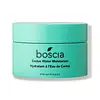What's inside
What's inside
 Key Ingredients
Key Ingredients

 Benefits
Benefits

 Concerns
Concerns

No concerns
 Ingredients Side-by-side
Ingredients Side-by-side

Water
Skin ConditioningButylene Glycol
HumectantGlycerin
HumectantCyclopentasiloxane
EmollientCarbomer
Emulsion StabilisingAmmonium Acryloyldimethyltaurate/Vp Copolymer
Sodium PCA
HumectantCaprylyl Glycol
EmollientPEG-10 Dimethicone
Skin ConditioningSodium Hyaluronate
Humectant1,2-Hexanediol
Skin ConditioningPotassium Hydroxide
BufferingDisodium EDTA
Saccharide Isomerate
HumectantPropanediol
SolventMelia Azadirachta Leaf Extract
Skin ConditioningMelia Azadirachta Flower Extract
Skin ConditioningCorallina Officinalis Extract
Skin ConditioningCereus Grandiflorus Flower Extract
Skin ConditioningCurcuma Longa Root Extract
MaskingCoccinia Indica Fruit Extract
Skin ConditioningAloe Barbadensis Flower Extract
EmollientSolanum Melongena Fruit Extract
Skin ConditioningOcimum Basilicum Flower/Leaf Extract
TonicMyrothamnus Flabellifolia Leaf/Stem Extract
HumectantOcimum Sanctum Leaf Extract
Skin ConditioningSimmondsia Chinensis Seed Extract
AbrasiveCitric Acid
BufferingEpilobium Angustifolium Flower/Leaf/Stem Extract
Skin ConditioningAscorbic Acid
AntioxidantPolysorbate 20
EmulsifyingPalmitoyl Tripeptide-1
Skin ConditioningPalmitoyl Tetrapeptide-7
Skin ConditioningWater, Butylene Glycol, Glycerin, Cyclopentasiloxane, Carbomer, Ammonium Acryloyldimethyltaurate/Vp Copolymer, Sodium PCA, Caprylyl Glycol, PEG-10 Dimethicone, Sodium Hyaluronate, 1,2-Hexanediol, Potassium Hydroxide, Disodium EDTA, Saccharide Isomerate, Propanediol, Melia Azadirachta Leaf Extract, Melia Azadirachta Flower Extract, Corallina Officinalis Extract, Cereus Grandiflorus Flower Extract, Curcuma Longa Root Extract, Coccinia Indica Fruit Extract, Aloe Barbadensis Flower Extract, Solanum Melongena Fruit Extract, Ocimum Basilicum Flower/Leaf Extract, Myrothamnus Flabellifolia Leaf/Stem Extract, Ocimum Sanctum Leaf Extract, Simmondsia Chinensis Seed Extract, Citric Acid, Epilobium Angustifolium Flower/Leaf/Stem Extract, Ascorbic Acid, Polysorbate 20, Palmitoyl Tripeptide-1, Palmitoyl Tetrapeptide-7
Water
Skin ConditioningGlycerin
HumectantCetearyl Ethylhexanoate
EmollientRosa Damascena Flower Water
MaskingAmmonium Polyacryloyldimethyl Taurate
Emulsion StabilisingHydroxyethylpiperazine Ethane Sulfonic Acid
BufferingPhenoxyethanol
PreservativeCaprylyl Glycol
EmollientIsopropyl Myristate
EmollientAscorbyl Glucoside
AntioxidantParfum
MaskingDimethiconol
EmollientPropanediol
SolventSodium Hyaluronate
HumectantXanthan Gum
EmulsifyingDisodium EDTA
Arginine
MaskingSodium Hydroxide
BufferingCitric Acid
BufferingSalicylic Acid
MaskingWater, Glycerin, Cetearyl Ethylhexanoate, Rosa Damascena Flower Water, Ammonium Polyacryloyldimethyl Taurate, Hydroxyethylpiperazine Ethane Sulfonic Acid, Phenoxyethanol, Caprylyl Glycol, Isopropyl Myristate, Ascorbyl Glucoside, Parfum, Dimethiconol, Propanediol, Sodium Hyaluronate, Xanthan Gum, Disodium EDTA, Arginine, Sodium Hydroxide, Citric Acid, Salicylic Acid
 Reviews
Reviews

Ingredients Explained
These ingredients are found in both products.
Ingredients higher up in an ingredient list are typically present in a larger amount.
Caprylyl Glycol is a humectant and emollient, meaning it attracts and preserves moisture.
It is a common ingredient in many products, especially those designed to hydrate skin. The primary benefits are retaining moisture, skin softening, and promoting a healthy skin barrier.
Though Caprylyl Glycol is an alcohol derived from fatty acids, it is not the kind that can dry out skin.
This ingredient is also used as a preservative to extend the life of products. It has slight antimicrobial properties.
Learn more about Caprylyl GlycolCitric Acid is an alpha hydroxy acid (AHA) naturally found in citrus fruits like oranges, lemons, and limes.
Like other AHAs, citric acid can exfoliate skin by breaking down the bonds that hold dead skin cells together. This helps reveal smoother and brighter skin underneath.
However, this exfoliating effect only happens at high concentrations (20%) which can be hard to find in cosmetic products.
Due to this, citric acid is usually included in small amounts as a pH adjuster. This helps keep products slightly more acidic and compatible with skin's natural pH.
In skincare formulas, citric acid can:
While it can provide some skin benefits, research shows lactic acid and glycolic acid are generally more effective and less irritating exfoliants.
Most citric acid used in skincare today is made by fermenting sugars (usually from molasses). This synthetic version is identical to the natural citrus form but easier to stabilize and use in formulations.
Read more about some other popular AHA's here:
Learn more about Citric AcidDisodium EDTA plays a role in making products more stable by aiding other preservatives.
It is a chelating agent, meaning it neutralizes metal ions that may be found in a product.
Disodium EDTA is a salt of edetic acid and is found to be safe in cosmetic ingredients.
Learn more about Disodium EDTAGlycerin is already naturally found in your skin. It helps moisturize and protect your skin.
A study from 2016 found glycerin to be more effective as a humectant than AHAs and hyaluronic acid.
As a humectant, it helps the skin stay hydrated by pulling moisture to your skin. The low molecular weight of glycerin allows it to pull moisture into the deeper layers of your skin.
Hydrated skin improves your skin barrier; Your skin barrier helps protect against irritants and bacteria.
Glycerin has also been found to have antimicrobial and antiviral properties. Due to these properties, glycerin is often used in wound and burn treatments.
In cosmetics, glycerin is usually derived from plants such as soybean or palm. However, it can also be sourced from animals, such as tallow or animal fat.
This ingredient is organic, colorless, odorless, and non-toxic.
Glycerin is the name for this ingredient in American English. British English uses Glycerol/Glycerine.
Learn more about GlycerinPropanediol is an all-star ingredient. It softens, hydrates, and smooths the skin.
It’s often used to:
Propanediol is not likely to cause sensitivity and considered safe to use. It is derived from corn or petroleum with a clear color and no scent.
Learn more about PropanediolSodium Hyaluronate is hyaluronic acid's salt form. It is commonly derived from the sodium salt of hyaluronic acid.
Like hyaluronic acid, it is great at holding water and acts as a humectant. This makes it a great skin hydrating ingredient.
Sodium Hyaluronate is naturally occurring in our bodies and is mostly found in eye fluid and joints.
These are some other common types of Hyaluronic Acid:
Learn more about Sodium HyaluronateWater. It's the most common cosmetic ingredient of all. You'll usually see it at the top of ingredient lists, meaning that it makes up the largest part of the product.
So why is it so popular? Water most often acts as a solvent - this means that it helps dissolve other ingredients into the formulation.
You'll also recognize water as that liquid we all need to stay alive. If you see this, drink a glass of water. Stay hydrated!
Learn more about Water